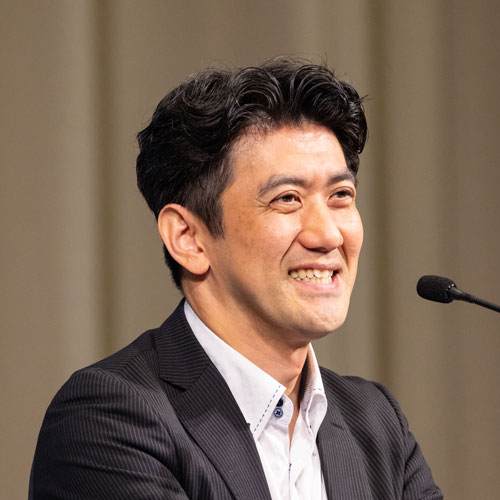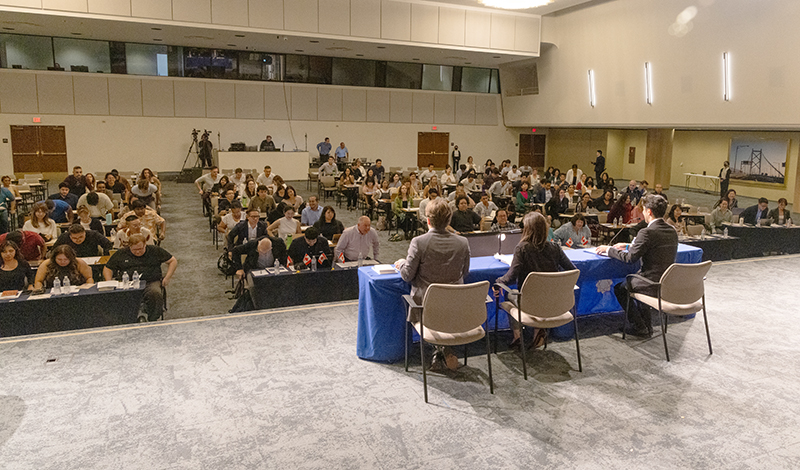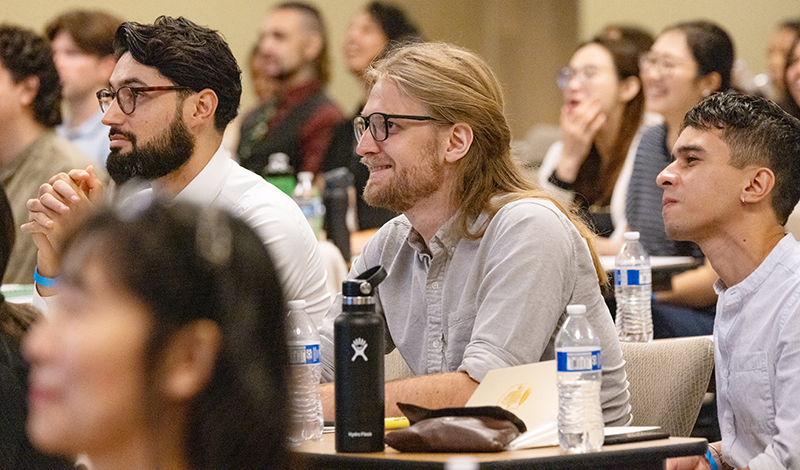SANTA MONICA, Calif.—Some 140 representative youth leaders from the five Southern California zones and SGI-Canada gathered on Aug. 27 at the World Peace Ikeda Auditorium to take part in the second day of the North America Study Conference, led by SGI Study Department Leader Seiichiro Harada.

Mr. Harada presented lectures on volume 1 of The Wisdom of the Lotus Sutra as well as key passages from The Record of the Orally Transmitted Teachings in the first North America Study Conference to be held since 2019. The day’s first lecture was broadcast live to youth members at 69 locations throughout the U.S. and Canada.
The day before, on Aug. 26, Mr. Harada led the first day of the study conference, attended by representative men’s and women’s leaders (see the Sept. 8, World Tribune, pp. 6–8).
A religion for the people.
Mr. Harada opened his first lecture with the turbulent context of Ikeda Sensei’s groundbreaking six-volume dialogue The Wisdom of the Lotus Sutra. The dialogues commenced in the early ‘90s, in the midst of the second priesthood issue. Mr. Harada was a student division member at the time, just preparing to enter college.
The Soka Gakkai had, since its establishment, striven to accomplish kosen-rufu, supporting the Nichiren Shoshu priesthood while speaking out at crucial junctures against it’s more disturbing tendencies. Yet, as the Soka Gakkai expanded into a global movement and Sensei engaged in dialogues with leading thinkers the world over to open pathways to peace, the chief priest Nikken Abe, blinded by jealousy and rage, hatched a plot with other priests to sow division within the Soka Gakkai—a plan they named “Operation C,” with the letter “C” standing for “cut.”
After denying all of the Soka Gakkai’s requests for dialogue, the priesthood, on Nov. 28 1991, excommunicated some 10 million Soka Gakkai members worldwide in an attempt to wrest control of the organization’s laity and resources. What’s more, they stopped conferring the Gohonzon to those who joined or belonged to the Soka Gakkai, thus attempting to use the object of devotion in Nichiren Buddhism as a tool of coercion.
Mr. Harada recalled how, amid this unjust oppression from the priesthood, the Soka Gakkai’s daily newspaper, Seikyo Shimbun, began publishing Sensei’s serialized lectures on the “Expedient Means” and “Life Span” chapters of the Lotus Sutra. And his dialogue, The Wisdom of the Lotus Sutra, began its serialization in the Daibyakurenge, the Soka Gakkai’s monthly study journal, adding powerful momentum to the Soka Renaissance.
“Sensei cast off the chains of an authoritarian religion that subjugated the common people, and he freely and dynamically began to teach the significance of Nichiren Buddhism being a ‘religion for the people’ from its inception,” Mr. Harada said.
Two years after its excommunication, in 1993, the Soka Gakkai began conferring the Gohonzon based on one transcribed by Nichikan Shonin, the great 18th-century restorer of Nichiren Buddhism. This marked the start of the organization’s dynamic development toward achieving worldwide kosen-rufu.
Ultimately, the priesthood’s scheme, “Operation C,” failed, causing a dramatic plunge in its own lay membership, while the Soka Gakkai, having achieved its “spiritual independence,” expanded its solidarity of the people to 192 territories and countries.
“In the midst of this battle with the priesthood, we studied The Wisdom of the Lotus Sutra, and I can say that for myself, my starting point in Buddhist study was reading this work by Sensei,” Mr. Harada said. “Once more, I will study in earnest together with you, our young successors in the youth, student and future divisions.”

The Supreme and Ultimate Purpose of Buddhas
All the various sutras left behind by Shakyamuni say that everyone is worthy of respect. But only the Lotus Sutra teaches that all people are Buddhas. Basing ourselves on the Mystic Law, the enlightenment of all people is made possible.
In the first of two lectures given by SGI Study Department Leader Seiichiro Harada on Aug. 27, the participants delved into volume 1 of The Wisdom of the Lotus Sutra, where Ikeda Sensei addresses what kind of teaching the Lotus Sutra is and how Nichiren Daishonin read this scripture and put it into practice. Sensei writes:
The Lotus Sutra teaches that the “one great reason” why Buddhas appear in the world—in other words, the supreme and ultimate purpose for the advent of Buddhas—is to enable all living beings to attain Buddhahood. (The Lotus Sutra and Its Opening and Closing Sutras, p. 64)
This goal cannot be accomplished unless the teachings preached by Shakyamuni are also effective for all those living after him, particularly those in the defiled age of the Latter Day of the Law. It is inconceivable, therefore, that the Buddha would fail to leave behind teachings for those living in later ages. The Lotus Sutra is the compassionate scripture he taught for precisely that reason.
Nichiren Daishonin read the Lotus Sutra with his life, revealing and propagating Nam-myoho-renge-kyo as the Law implicit in this sutra, which is designed to enable all people to become happy. The Daishonin was the first to demonstrate how to realize the ideal of the Lotus Sutra to bring happiness to all people in the Latter Day of the Law, when the Buddha’s teachings were predicted to perish.[1]
Mr. Harada reviewed the main storyline of the “Expedient Means” chapter, starting with its first scene, where Shakyamuni arises from deep meditation and turns to Shariputra, known as the “foremost in wisdom,” and begins to speak, saying:
The wisdom of the Buddhas is infinitely profound and immeasurable. The door to this wisdom is difficult to understand and difficult to enter. Not one of the voice-hearers or pratyekabuddhas is able to comprehend it.[2]
What is the “infinitely profound and immeasurable” wisdom of the Buddhas? Shakyamuni explains that the “true aspect of all phenomena can only be understood and shared between Buddhas”[3] and that this wisdom comes from mastering the “true aspect of all phenomena.”
Shakyamuni then reveals that the “true aspect of all phenomena” consists of the “appearance, nature, entity, power, influence, inherent cause, relation, latent effect, manifest effect, and their consistency from beginning to end.”[4]
In the second scene, Shakyamuni endlessly praises the wisdom of the Buddha, but the people of the two vehicles (voice-hearers and cause-awakened ones) in the assembly harbor doubts.
Shariputra, representing the entire assembly, begs Shakyamuni to reveal the reason for his praise of this infinitely profound Law, but Shakyamuni refuses. After Shariputra’s third appeal, Shakyamuni decides to preach the Lotus Sutra.
“However, at that time, five thousand arrogant individuals among the four categories of believers (laymen, laywomen, nuns and monks) stand up and leave the assembly before the Buddha begins preaching, believing they have no need to hear the teachings of Shakyamuni,” Mr. Harada said. “Without uttering a word, Shakyamuni allows them to leave in silence.”
In the third scene, Shakyamuni explains that “the Buddhas, the World-Honored Ones, appear in the world for one great reason alone.”[5]
He then reveals that the teachings he had expounded prior to the Lotus Sutra called the three vehicles—teachings for voice hearers, cause-awakened ones and bodhisattvas—were expedient means, and that the true intent of the Buddha was to lead all people to enlightenment through the teaching of the “one vehicle” of the Lotus Sutra. This is called the “replacement of the three vehicles with the one vehicle.”
“The Buddha vows to lead all people in revealing the the same state of life he has attained—which Shakyamuni describes as ‘making all persons equal to me, without any distinction between us,’” Mr. Harada said. “He fulfills this vow by expounding the Lotus Sutra.”
‘Expedient means’ are educational techniques for leading people to Buddhahood.
Mr. Harada touched on three Buddhist concepts highlighted on in The Wisdom of the Lotus Sutra: “expedient means,” “the replacement of the three vehicles with the one vehicle” and “the true aspect of all phenomena.”
In the Sanskrit text of the Lotus Sutra, the expression “expedient means” in the second chapter’s title is upaya kaushalya, which can also be translated as “skillful approach.”
Sensei elaborates:
[E]xpedient means are educational techniques for leading people to Buddhahood. The spirit of the Lotus Sutra is to bring each human being’s enormous potential into fullest flower, and for that the Buddha uses expedient means. Expedient means are methods for educating people in the broadest sense.[6]
Why did Shakyamuni employ expedient means? Before expounding his teachings, he was troubled over whether to teach others the Law to which he had awakened. “If he preached his enlightenment, there were those who might be unable to believe in it and might instead reject the Law and fall into the three evil paths,” Mr. Harada said. “If that were to happen, he thought, it might be better to not preach the Law.”
However, in the “Expedient Means” chapter, Shakyamuni explains that the Buddhas of the ten directions then encouraged him, saying, “But following the example of all other Buddhas, you will employ the power of expedient means.”[7] That was when Shakyamuni resolved to preach the Law.
Sensei explains:
Shakyamuni’s hesitation derived from his profound compassion. To have compassion means to feel others’ sufferings as one’s own. Because the Buddha is filled with the desire to save others, he agonizes over how to achieve this. Such compassion gives rise to wisdom. This is the power of expedient means and the art of human education. In a certain sense, therefore, a Buddha is someone who is always thinking and agonizing over how to develop others’ ability to achieve happiness, as well as over how to fulfill his or her own mission.[8]
“In other words, the teachings prior to the Lotus Sutra were expedient means for leading people toward the truth, and they arose from Shakyamuni’s compassion,” Mr. Harada said.
The ‘replacement of the three vehicles with the one vehicle’ engendered a fundamental transformation in the life of the disciple.
The “replacement of the three vehicles with the one vehicle” is a central component of the theoretical teaching of the Lotus Sutra, which starts in the “Expedient Means” chapter.
The “three vehicles” are the teachings preached for voice-hearers, cause-awakened ones and bodhisattvas.
Mr. Harada explained that the word vehicle is used to describe teachings that, like vehicles, carry people. The function of the vehicles described by the Buddha is to carry people to higher states of life.
Why then did the Buddha expound three different vehicles instead of just the single Buddha vehicle? “That is because, depending on people’s varying life states, there was a need to teach the Law through the use of expedient means.”
Sensei explains:
To his followers, it seemed as if Shakyamuni had set forth three separate teachings, but to the Buddha there is only one Buddha vehicle and no other. The one Buddha vehicle is a teaching that enables all people to attain Buddhahood; it is endowed with the function of opening and revealing the Buddha wisdom and awakening and guiding people to the realm of Buddhahood.[9]
Sensei goes on to explain the fundamental transformation that this revelation engendered in the minds of the Buddha’s disciples. After the replacement of the three vehicles with the one vehicle, his disciples walked the path of the “oneness” of mentor and disciple. Sensei elaborates:
The “original vow” of the Buddhas is to enable all people to walk their same path toward enlightenment.
Of course, the practitioners of the three vehicles of the sutras before the Lotus Sutra also believed in and followed the Buddha. And in their fashion, they followed the way of mentor and disciple. But these disciples always felt an unbridgeable gap between them and their mentor: the disciple was the disciple and the Buddha was the Buddha. The disciple did not know the mind of the mentor. The Lotus Sutra, however, broke through this deluded belief.
The replacement of the three vehicles with the one vehicle engendered a fundamental transformation in the mind and the way of life of the disciple—a transformation from the way of mentor and disciple to the way of the oneness of mentor and disciple.[10]
Prior to the Lotus Sutra, the disciples of the three vehicles were said to be unable to attain Buddhahood, although they aspired to do so. They also could not save other living beings. “In other words, though they followed the teachings of their mentor, the Buddha, they were unable to fulfill the Buddha’s wish of attaining Buddhahood themselves,” Mr. Harada said. “We could say this is because they were simply walking the path of disciples or the path of mentor and disciple.”
On the other hand, based on the principle of the “mutual possession of the Ten Worlds,” after the one great vehicle replaced the three vehicles—voice-hearers, cause-awakened ones, bodhisattvas—all living beings were equally able to attain Buddhahood. What’s more, they stood up to help all people attain Buddhahood.
“In other words, the desire of the Buddha for all people to attain Buddhahood also became the desire of the disciples,” Mr. Harada said. “Mentor and disciple walk a shared path toward the same goal. We can call this the path of the oneness of mentor and disciple.”
The way of the oneness of mentor and disciple refers to fostering the same heart as the mentor, standing up with the same prayer and fighting for the same cause.

The “true aspect of all phenomena” grasps the supreme truth and teaches it to others.
The “true aspect of all phenomena” is a principle about transforming reality. Where in “Expedient Means” is this principle expounded? We recite this portion every day during gongyo:
What the buddhas have achieved is the rarest and most difficult-to-understand Law. The true aspect of all phenomena can only be understood and shared between buddhas. This reality consists of the appearance, nature, entity, power, influence, internal cause, relation, latent effect, manifest effect, and their consistency from beginning to end.[11]
“All phenomena” here refers to all matter and things in the universe. “True aspect” refers to the true reality or nature of things, just as they are. In other words, the “true aspect of all phenomena” can be described as the true, unaltered form of all existence.
Sensei explains the relationship between the “true aspect” and “all phenomena” in the following way:
The Buddha’s revelation of the true aspect of all phenomena is very important. The truth (true aspect) of things is not found in some far distant realm removed from reality. In this unwavering focus on the true form (true aspect) of everyday reality, never moving away from real things and events (all phenomena), we can discern the true brilliance of the Buddha’s wisdom.
The “Life Span” chapter says: “The Thus Come One perceives the true aspect of the threefold world exactly as it is” (LSOC, 267). The “threefold world” is the world of reality. The Buddha is determined never to become alienated or divorced from the actual world (all phenomena). At the same time, the Buddha is not influenced by the superficial appearance of the actual world (all phenomena) but instead grasps the supreme truth (true aspect) concealed therein and teaches it to others so that they may understand and apply it in their own lives. This is the wisdom of Buddhism.
The expression “the true aspect of all phenomena” brims with thorough-going realism and wisdom for surmounting our immediate circumstances that are both so characteristic of Buddhism.[12]
Here and now is our true and eternal sphere of activity.
In The Wisdom of the Lotus Sutra, Sensei reaffirms the viewpoint that the true aspect of all phenomena is not divorced from reality; it is the principle for transforming reality that enables us to bring forth the wisdom to overcome the challenges reality presents us with.
Sensei goes on to say that, on an individual level, the true aspect of all phenomena can be realized by attaining Buddhahood in this lifetime, and it is achieved on a social level through “establishing the correct teaching for the peace of the land.”
He writes:
The sole purpose of Buddhism, the sole purpose of the SGI, is to save people from suffering. The SGI is doing its utmost to bring happiness to humanity. It has no other reason for existing.
How praiseworthy are the lives of those who strive toward that goal with the SGI! How noble!
From the perspective of the true aspect of all phenomena, the here and now is our true and eternal sphere of activity. It is the actual stage on which we perform our missions. The Daishonin writes, “It is not that he leaves his present place and goes to some other place” (OTT, 192). Even difficult situations, the kind we can only ascribe to our negative karma, are precious, never-to-be-repeated opportunities to fulfill our original mission.
In that respect, those who understand the wisdom of the true aspect of all phenomena can transform any kind of karma into a radiantly brilliant mission.[13]
Mr. Harada said that the heart of the true aspect of all phenomena exists in this endless battle to transform reality.
“The youth, student and future division members of SGI North America have now studied Ikeda Sensei’s principle of transforming reality based on the ‘Expedient Means’ section of The Wisdom of the Lotus Sutra,” he said. “Wherever we may be, with faith in the Gohonzon as our foundation, let us advance with dignity toward our human revolution and establishing the correct teaching for the peace of the world!”
—Prepared by the World Tribune staff
September 15, 2023, World Tribune, pp. 6–8
References
- The Wisdom of the Lotus Sutra, vol. 1, p. 45. ↩︎
- The Record of the Orally Transmitted Teachings, p. 24. ↩︎
- The Lotus Sutra and Its Opening and Closing Sutras, p. 57. ↩︎
- Ibid. ↩︎
- Ibid., p. 64. ↩︎
- WLS-1, p. 117. ↩︎
- LSOC, p. 77. ↩︎
- WLS-1, 120. ↩︎
- Ibid., 115. ↩︎
- Ibid., 157. ↩︎
- LSOC, 57. ↩︎
- WLS-1, 170. ↩︎
- Ibid., 190. ↩︎
You are reading {{ meterCount }} of {{ meterMax }} free premium articles

